This set of Molecular Endocrinology Multiple Choice Questions & Answers (MCQs) focuses on “Obesity and Regulation of Body Mass – Set 2”.
1. Which enzyme is synthesized by leptin in the liver and muscle, in order to inhibit fatty acid synthesis?
a) AMPK
b) GMPK
c) CMPK
d) AMPP
View Answer
Explanation: In order to reduce the fatty acid synthesis, leptin synthesize AMP- activated protein kinase (AMPK). The action of this enzyme inhibits fatty acid synthesis. This leads to the activation of fatty acid oxidation which in turn helps in the energy generating activities in the body.
2. How does insulin helps in the reduction of fuel intake in the body?
a) By inhibiting alpha MSH, and stimulating NPY
b) By inhibiting NPY, and stimulating alpha MSH
c) By inhibiting leptin and stimulating kinases
d) By increasing the production of mitochondria in the adipose tissues
View Answer
Explanation: In the orexigenic neurons, insulin receptors inhibits the NPY (Neuropeptide Y) and in the anorexigenic neurons insulin stimulates the synthesis of alpha MSH. This reduces the intake of fuel which increases thermogenesis.
3. Which is the peptide hormone that is exclusively synthesized in adipose tissues to sensitize other hormones to insulin action?
a) Leptin
b) Kinetin
c) Adiponectin
d) Secretin
View Answer
Explanation: Adiponectin is an adipokine which is synthesized in the adipose tissue in order to make other organs more susceptible to insulin action. This hormone circulates in the blood and take part in the metabolism of fatty acids and carbohydrates in the liver and muscles.
4. Which hormone produced in the stomach, acts on the orexigenic neurons to stimulate appetite?
a) Lipase
b) Angiotensin
c) Leptin
d) Ghrelin
View Answer
Explanation: Ghrelin is the hormone produced in the stomach that acts on the orexigenic neurons in order to stimulate hunger before eating. Another hormone produced from the intestine reduces this hunger after eating.
5. Microbial flora in the gut of human beings produces secondary bile acids that induces the release of gut hormones.
a) True
b) False
View Answer
Explanation: In the gut of human beings, there are microbial flora that produce many fermentation products as well as secondary bile acids. This induces the release of gut hormones which in turn regulates the body weight of an individual.
6. What is the role of adiponectin receptors in the hypothalamus regarding fat metabolism?
a) Reduce food intake
b) Stimulate food intake
c) Increase energy expenditure
d) Breakdown of fatty acids
View Answer
Explanation: Adiponectin receptors are also present in the hypothalamus. They activate AMPK in the hypothalamus which leads to the tendency to take food. When food intake is stimulated this in turn reduces the energy expenditure.
7. AMPK inhibits fatty acid synthesis and cholesterol synthesis.
a) True
b) False
View Answer
Explanation: AMPK inhibits the enzyme malonyl-CoA which is an important enzyme in the beta oxidation. Thus, it prevents the fatty acid synthesis. AMPK also prevents cholesterol synthesis by inactivating the enzyme HMG-CoA reductase (important enzyme in cholesterol synthesis) by phosphorylating it.
8. In the given diagram, what leads to the synthesis of AMP, which in turn leads to the production of AMPK that regulates the anabolic and catabolic processes?
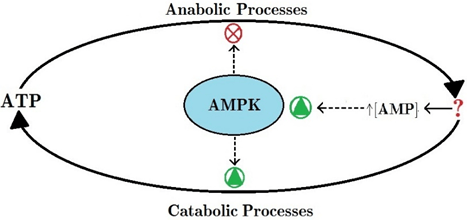
a) Leptin
b) GTP
c) GDP
d) ADP
View Answer
Explanation: Adenylate kinase converts ADP produced in synthetic reactions to AMP. AMP activates AMPK, which by phosphorylating the key enzymes regulates the anabolic and catabolic pathways.
9. Which among the following is a drug to increase the expression of adiponectin mRNA in adipose tissue?
a) Equanil
b) Azithromycin
c) Zintec
d) Rosiglitazone (Avandia)
View Answer
Explanation: Rosiglitazone (Avandia) is a drug used in the treatment of type 2 diabetes which belongs to the class of thiazolidinediones. This drug helps to increase the adiponectin levels in blood by increasing the expression of adiponectin mRNA. In the adipose tissue.
10. In the given diagram, which molecule is binding to the cognate ligand (L) that responds to changes in dietary lipid?
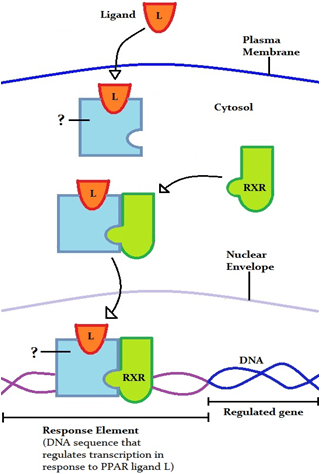
a) Adiponectin receptors
b) Peroxisome proliferator-activated receptors (PPARs)
c) Leptin
d) Insulin
View Answer
Explanation: Peroxisome proliferator-activated receptors (PPARs) function in the nucleus by forming heterodimers with another nuclear receptor, RXR (retinoid X receptor). They respond to changes in dietary lipids by altering the expression of fat and carbohydrate metabolism genes.
11. Which among the following is a disease in which the hormone ghrelin levels are high that leads to obesity?
a) Phenylketonuria
b) Maple Syrup Urine disease
c) Prader Willi syndrome
d) Down’s syndrome
View Answer
Explanation: There is an uncontrollable appetite in individuals with Prader Willi syndrome. Their blood levels of ghrelin are extraordinarily high, leading to severe obesity that frequently results in death before the age of 30.
12. Which among the following is a peptide hormone with 34 amino acids that rises in concentration in the blood after a meal?
a) Leptin
b) Adiponectin
c) Ghrelin
d) PYY3-36
View Answer
Explanation: PYY3-36 is a peptide hormone of 34 amino acids which is secreted by endocrine cells in the lining of the small intestine and colon. In the blood, the amount of PYY3-36 increases after a meal, and for a few hours it stays high.
13. Which among the following is the proper graph which represents, the correct level of ghrelin levels relative to the timing of meals?
a)
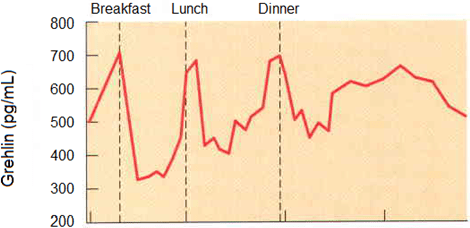
b)
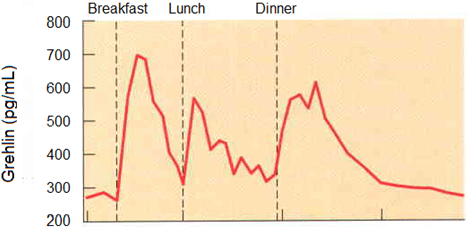
c)
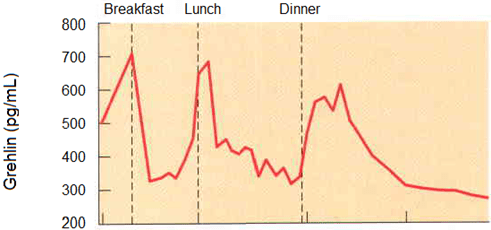
d)
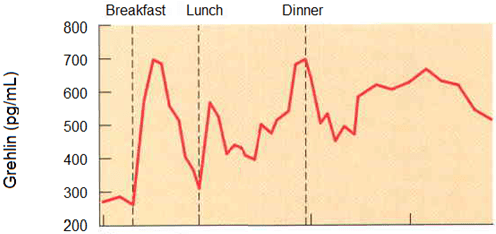
View Answer
Explanation: Ghrelin plasma concentrations increase sharply just before the usual time for having food (7 a.m. breakfast, 12 a.m. lunch, 5:30 p.m. dinner) and drop-off right after the meals. The feeling of hunger is related to this.
Sanfoundry Global Education & Learning Series – Molecular Endocrinology.
To practice all areas of Molecular Endocrinology, here is complete set of 1000+ Multiple Choice Questions and Answers.
If you find a mistake in question / option / answer, kindly take a screenshot and email to [email protected]
